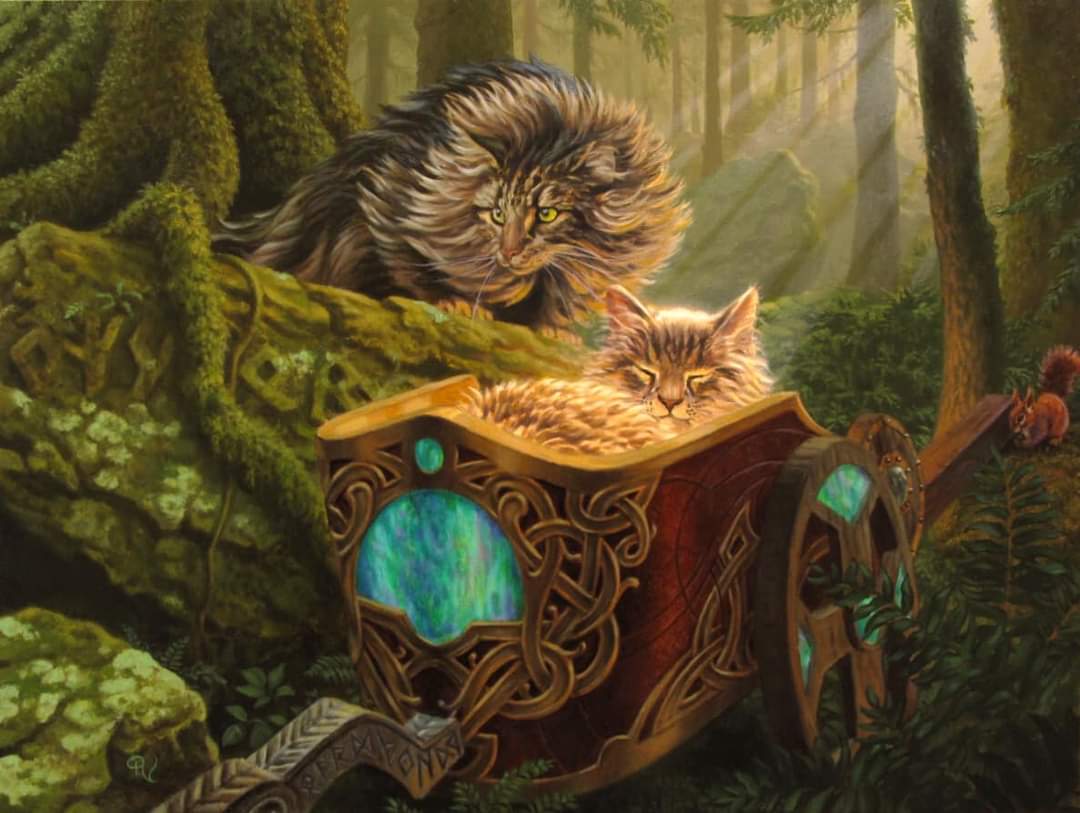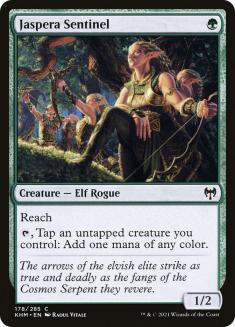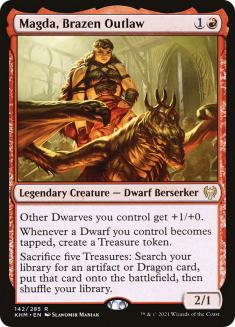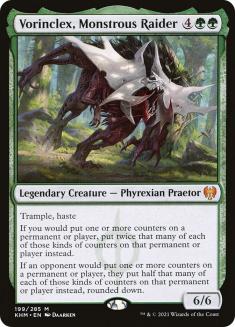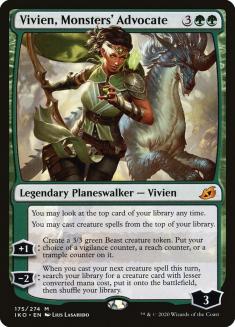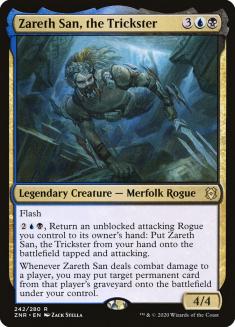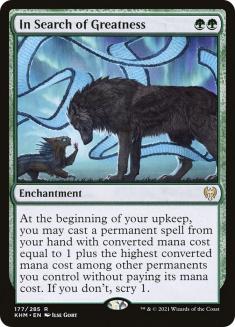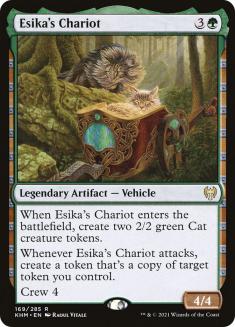Kaldheim is upon us, and in typical fashion, everyone is excited to play with all the new cards. But in the rush to find Standard’s next big thing, it’s important not to lose sight of the decks that have defined the format over the last three months. In all likelihood, those decks will be a large portion of the new metagame, and unless something drastic changes, they will continue to be a major part of the metagame for the coming months.
However, that doesn’t mean that those decks will remain the same. They have the chance to upgrade with the new options that Kaldheim offers as well. So in the interest of looking forward to the opening weeks of this Standard season, here is how I would build the three decks that, in my estimation, were the most successful archetypes last season: Gruul Adventures, Dimir Rogues, and Mono-Green Food.
Gruul Adventures
Creatures (29)
- 2 Scavenging Ooze
- 4 Lovestruck Beast
- 4 Edgewall Innkeeper
- 4 Bonecrusher Giant
- 2 Kazandu Mammoth
- 3 Magda, Brazen Outlaw
- 2 Vorinclex, Monstrous Raider
- 4 Goldspan Dragon
- 4 Jaspera Sentinel
Lands (8)
Spells (23)

This was Standard’s best deck last season, and Goldspan Dragon, the early frontrunner for best card from Kaldheim, looks to be a great addition. But I’m not stopping there. To supplement the addition of Goldspan Dragon I want more mana acceleration. Ramping into a big flying Dragon has a long history of success in Standard and this may just supplant Glorybringer as best in show.
Tangled Florahedron would be an easy option, but the combination of Jaspera Sentinel and Magda, Brazen Outlaw is significantly more explosive. When you start the game on those two creatures, you can immediately create a Treasure token, which along with the mana from Sentinel itself can cast a Stomp to keep your opponent off-balance. Then on Turn 3 you still have access to five mana for Goldspan Dragon. Frankly, that’s a ridiculous curve.
If you hold on to that first Treasure, you’ll have access to six mana on Turn 3, so I wanted to include a good threat at that spot on the curve. Vorinclex, Monstrous Raider is another of the most powerful cards in Kaldheim and is a perfect threat for a deck that is now heavily focused on accelerating into heavy-hitting creatures. Not only is it a solid creature on rate, it shuts down several of the most-played removal spells for large creatures in the metagame, namely Elspeth Conquers Death, The Akroan War, and Binding the Old Gods.
The cost of these additions is moving Vivien, Monsters’ Advocate to the sideboard for matchups where your opponents have quality answers to your big creatures, like Heartless Act, as well as cutting some of the aggressive creatures that filled out the early spots on the curve, namely Brushfire Elemental and Kazandu Mammoth. And as good as those cards are, I’d rather focus on getting to those powerful high-end threats.
My worry is how well Jaspera Sentinel and Magda will perform when you don’t draw them together. Sentinel looks to be solid, since you have Edgewall Innkeeper and Human tokens from Heart’s Desire as other fodder to tap for mana. Those creatures rarely get into combat, so you should be accelerating at a relatively low cost. Magda is more worrisome, since without Sentinel it has to attack to generate Treasures, and Gruul Adventures doesn’t have a lot of ways to clear out blockers. But its ceiling is so high that I think it’s worth the risk.
The last addition I’ve made is two copies of Snakeskin Veil. When you’re accelerating into powerful threats, there’s a lot of value in cheaply protecting them. Veil does that while pairing especially well with Goldspan Dragon. Keep in mind that the Dragon triggers when targeted by your spells too, so Snakeskin Veil can act as a Lotus Petal of sorts by generating a Treasure that sacrifices for two mana. That can take an opponent by surprise if they think you’re one mana shy of casting a key interactive spell or Embercleave.
In the sideboard, I expect Klothys, God of Destiny to be a staple since Blightstep Pathway looks to bolster the historically shaky Rakdos mana base. The second copy is a strong consideration should Rakdos decks rise to prominence. I’m also lower on escape cards since I think Dimir Rogues will have a lot more competition among control decks and thus won’t be as prominent. Against more traditional control decks, especially those with Doomskar, you’ll want your copies of Vivien, Monsters’ Advocate over something like Ox of Agonas.
Dimir Rogues
Creatures (16)
- 2 Gadwick, the Wizened
- 3 Brazen Borrower
- 4 Thieves' Guild Enforcer
- 3 Zareth San, the Trickster
- 4 Soaring Thought-Thief
Lands (17)
Spells (27)

Standard’s premier control deck, Dimir Rogues went through multiple iterations last season. Some lists played Ruin Crab while some didn’t. Some lists played Lurrus of the Dream-Den as a companion while some opted for maindeck copies of Shark Typhoon. And towards the end of the season we saw lists with Zareth San, the Trickster.
I think the Zareth San lists will become the default variant for Dimir Rogues this season, and it looks like one of Magic Online’s (MTGO’s) most notable grinders, Phill_Hellmuth, agrees. The format is only getting more powerful, and that means control decks have less time to durdle with low-impact cards. I don’t like messing around with cards like Merfolk Windrobber and Of One Mind as many current lists are. When I saw this list from one of last weekend’s Challenges, it looked much better-suited for my expected metagame.
One key element is an increased reliance on counterspells, because Essence Scatter and Didn’t Say Please are the best ways to interact with Goldspan Dragon. Additional copies of Didn’t Say Please also help make up for the lack of Ruin Crab so your mill payoff cards still come online reliably. That said, trimming a copy of Into the Story, even though it’s seemingly untouchable in the archetype, also makes sense when you don’t have Crab and can’t afford to get stuck with it in your hand in the early-game. Gadwick, the Wizened offers card advantage that won’t clog your hand early and offers some extra control over the battlefield against these powerful creature decks.
When it comes to the removal package, I like at least three copies of Heartless Act in the split because it answers both Goldspan Dragon and Vorinclex. I’m not high on Eliminate, and would consider playing more copies of Bloodchief’s Thirst to lower your curve, but it’s generally smart to diversify your removal spells.
But the biggest reason to play this list is the aforementioned legendary Merfolk Rogue. There are many high-impact permanents to return with it now, from the ubiquitous Goldspan Dragon to the similarly hyped Showdown of the Skalds. You may be worried that Goldspan Dragon will bring more removal spells into the metagame that efficiently answer 4/4 creatures, but know that Dimir Rogues is happy to bide its time and play the one-for-one game.
Once you give up on Lurrus of the Dream-Den, you get access to Shark Typhoon out of the sideboard, which will be quite important against the Izzet Midrange decks. Outside of that, you see most of the same hits here.
Dimir Rogues may not directly benefit from adding new cards, but it’s the best-poised deck to take advantage of players tapping out for powerful four- and five-mana threats since they have so much efficient disruption. But it’s important to find the right mix of that disruption and I think this list does a good job of that.
I also like moving in a more proactive direction, since as the rest of the metagame grows in power level, you don’t have the luxury of sitting back and winning via attrition every game. The Zareth San package gives you another angle of attack, and one that grows in power as the metagame grows in kind.
Mono-Green Food
Creatures (25)
- 4 Gilded Goose
- 4 Lovestruck Beast
- 4 Wicked Wolf
- 3 Feasting Troll King
- 2 Elder Gargaroth
- 3 Tangled Florahedron
- 3 Kazandu Mammoth
- 2 Vorinclex, Monstrous Raider
Planeswalkers (2)
Lands (6)
Spells (27)

Mono-Green Food was the midrange deck of the format, and like Gruul Adventures it can seamlessly incorporate some powerful cards from Kaldheim. With four copies of Castle Garenbrig, it’s the best home for Vorinclex, giving the deck a bit more closing speed. But the additions don’t end there.
We all know how powerful casting spells for free can be, and scrying to find your next threat if you’re on empty means this card has a reasonable floor in addition to that high ceiling. I really wanted to find space for a third copy, but the list is very tight, and I already shaved a copy each of Tangled Florahedron and Kazandu Mammoth. The fact that In Search of Greatness is weak in multiples means that I’m okay only playing two copies, since you really only want to draw one in a given game. But if that first copy consistently impresses, I’ll find the room to squeeze in a third.
Once you add In Search of Greatness, it’s important to keep the curve somewhat uniform. That meant adding a few more five-drops than this deck might otherwise play. That said, I like Elder Gargaroth quite a bit in a metagame where everyone is trying to play Goldspan Dragon. It’s effectively a proactive answer to the powerful flyer.
I also added the fourth Trail of Crumbs to the maindeck where most lists these days sideboard the last copy, in large part due to how well it plays with In Search of Greatness. Search frees up your mana to use on Trail, even if you have to sacrifice Food tokens the expensive way, so extra copies won’t go unused as often. In turn, Trail of Crumbs lets you dig through your deck to find cards of the correct cost to take advantage of Search. When this pairing is humming, your deck is going to look absurd, drawing cards and casting multiple powerful spells every turn.
Esika’s Chariot is my pick for the most overlooked card in the set. I’ve seen it in a few lists, but it’s not getting a lot of hype on social media, and it’s been very impressive every time I’ve cast it or had it cast against me. I particularly like it alongside the Food engine, since that means you have the option of creating a Cat token and pressing your advantage on the battlefield or making a Food token that will later turn into a card in conjunction with Trail of Crumbs. Making Food insulates you from a sweeper, which is what Chariot demands as an answer.
Chariot is just so efficient on rate and gives you a ton of options for controlling the battlefield. The Vehicle itself stops plenty of attackers, and the Cat tokens make it difficult for opponents to go wide. Against control decks, the value it produces forces them to leave up removal, but you are by no means required to run the Vehicle into a Heartless Act. You can pressure them just fine with the Cat tokens and whittle down their resources, all the while leaving a huge threat in your back pocket.
Esika’s Chariot is my pick for the most overlooked card in the set.
If the Cat tokens die, you have Humans from Heart’s Desire and Beasts from Vivien you can copy, so they are forced to answer the Vehicle itself, at which point you are still left with those Cat tokens. The card is just impossible to interact with efficiently outside of counterspells, and Essence Scatter isn’t going to do it.
When it comes to playing midrange decks, you need the ability to seamlessly transition between playing offense and playing defense, and Esika’s Chariot has that ability without sacrificing anything in terms of raw rate. It fits so well into this deck that I’d like a third copy, but it occupies the same spot on the curve as Wicked Wolf, which is indispensable as a source of interaction.
The Common Thread
These three decks are all different on a fundamental level. One is an aggro deck, another a control deck, and the third a midrange deck. But when it came to adjusting to the new metagame, they all adapted in a similar way. All of these lists prioritize getting onto the battlefield and controlling the battlefield in a proactive way.
This shouldn’t be surprising if you look back on the history of Standard’s past. As the format grows, decks become more streamlined, and that consistency means that you don’t have time to durdle. You need to execute your gameplan more efficiently and get to your powerful spells sooner.
That doesn’t mean reactive control decks won’t be viable. I expect that, as the metagame takes shape, there will be windows of opportunity for those kinds of decks to thrive. But the decks that will be near the top of the standings week in and week out will be proactive.
I expect all three of these archetypes to be competitive for at least the early weeks of the metagame. So if you want to keep playing your favorite deck from last season, you should. But if you’re looking for something new, be sure to build your new list with the updated versions of these archetypes in mind. Trying to beat the old season’s top decks will only leave you behind if you aren’t considering how they are going to incorporate the new cards.

